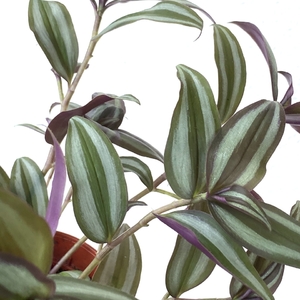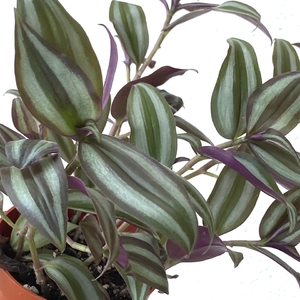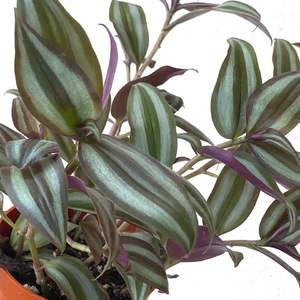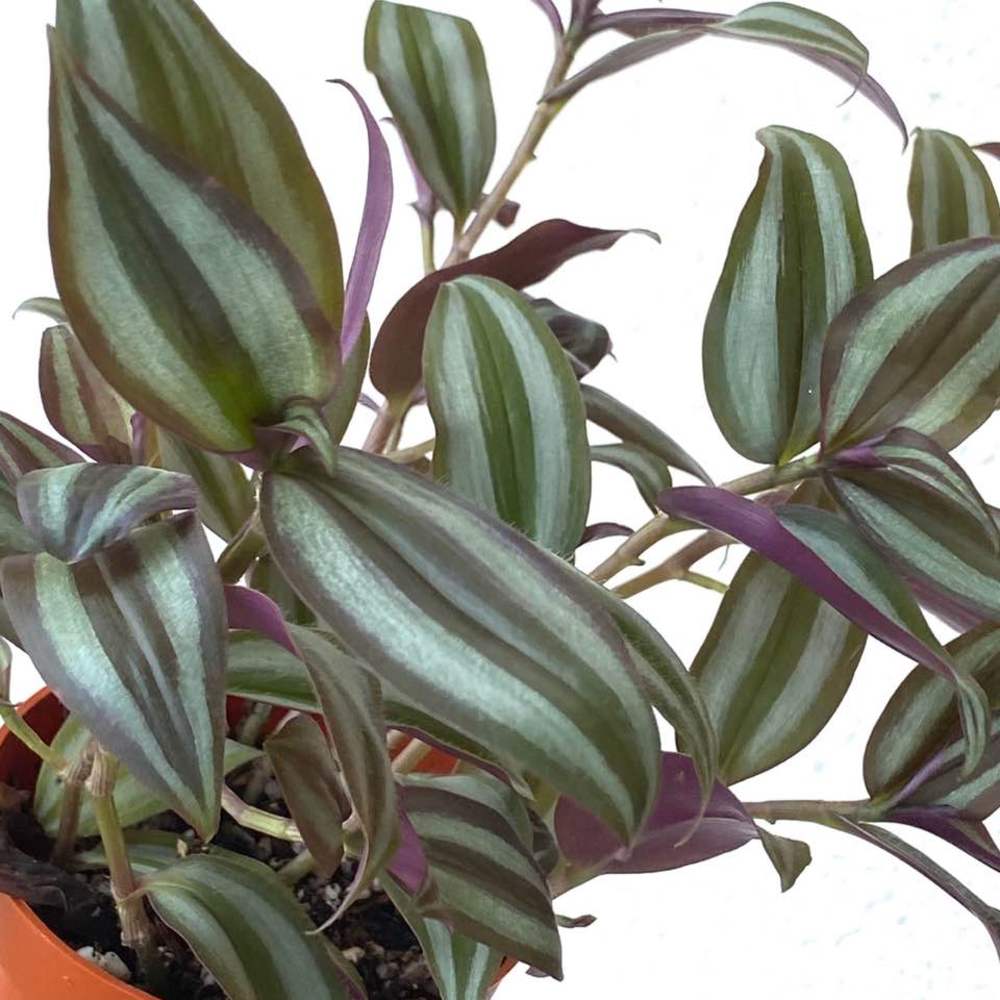植物经验
详细说明
Wandering Jew plants, are fast growing easy care plants that are perfect to hang in front of a window that gets bright indirect light. The zebrina variety has long vines covered in small stemless leaves about 2” in length. The colorful patterned leaves are green with purple stripes and a silver shine. The underside of the leaf is a deep purple or magenta color. There are other varieties of Wandering Jew plants that have pink, off-white, or a bronze stripe in their leaves. The “fluminensis” Wandering Jew plant has small, solid green leaves and white flowers while the “palida” variety has purple leaves with white, purple, or pink flowers. Wandering Jew plants, native to South America and Mexico, are commonly used in the Tabasco region of Mexico to make a cold herbal tea called Matali.
These plants, especially the sap, are considered slightly poisonous and should be kept away from pets and children.
LIGHT
Wandering Jew plants like bright indirect light. The better the light, the more flowers and colorful leaves a Wandering Jew plant produces. Direct sun causes the purple and cream colors in the leaves to fade.
WATER
Water well and then allow the top 2" to 3" of soil to dry out before watering again. If the soil of a Wandering Jew plant stays too dry and the plant is in bright light, the leaves become stunted and lose color. Over watering causes root rot.
FERTILIZER
Feed monthly when a Wandering Jew plant is producing new growth with a water-soluble houseplant food diluted to 1/2 the recommended strength. Using a plant food high in nitrogen helps a Wandering Jew plant produce more colorful leaves. Over- fertilizing is another reason why the bright colors in the leaves start to fade.
TEMPERATURE
A Wandering Jew plant grows well in temperatures between 60°- 80°F (15.6°- 26.7°C).
HUMIDITY
Average to higher household humidity is best. If the air is too dry, the leaf tips of a Wandering Jew plant turn brown. Place a Wandering Jew plant on a tray of wet pebbles to increase the humidity around it. Be sure the plant is sitting on the pebbles and not in the water.
FLOWERING
In ideal growing conditions, a Wandering Jew plant produces small white, pink, or purple flowers.
PESTS
Although Wandering Jew plants are fairly pest resistant, Aphids, scale, and Mealy Bugs can be a problem. See pictures and read more about these Plant Pests in the Glossary of the website.
DISEASES
The high humidity Wandering Jew plants prefer encourages fungal and bacterial infections.
SOIL
Use a well- aerated soil that drains quickly. If the soil seems heavy and clay-like, add some peat moss and perlite.
POT SIZE
A Wandering Jew plant is a fast growing plant so check the root-ball frequently to see if it needs re-potting. Move to the next size pot, nothing larger, and be sure there are drip holes in the bottom.
PRUNING
The vines of a Wandering Jew plant get very long and leggy as the plant matures; don’t hesitate to aggressively prune a Wandering Jew plant. When pruning, cut the long stems above a leaf node (the place where the leaf is attached to the stem). It may take a while for the trimmed stems to bush out again, so be patient. Use the clippings to propagate new plants.
PROPAGATION
Wandering Jew plants are easily propagated from Stem Cuttings. When propagating, be sure to remove all leaves within two inches of the bottom of the cutting.
These plants, especially the sap, are considered slightly poisonous and should be kept away from pets and children.
LIGHT
Wandering Jew plants like bright indirect light. The better the light, the more flowers and colorful leaves a Wandering Jew plant produces. Direct sun causes the purple and cream colors in the leaves to fade.
WATER
Water well and then allow the top 2" to 3" of soil to dry out before watering again. If the soil of a Wandering Jew plant stays too dry and the plant is in bright light, the leaves become stunted and lose color. Over watering causes root rot.
FERTILIZER
Feed monthly when a Wandering Jew plant is producing new growth with a water-soluble houseplant food diluted to 1/2 the recommended strength. Using a plant food high in nitrogen helps a Wandering Jew plant produce more colorful leaves. Over- fertilizing is another reason why the bright colors in the leaves start to fade.
TEMPERATURE
A Wandering Jew plant grows well in temperatures between 60°- 80°F (15.6°- 26.7°C).
HUMIDITY
Average to higher household humidity is best. If the air is too dry, the leaf tips of a Wandering Jew plant turn brown. Place a Wandering Jew plant on a tray of wet pebbles to increase the humidity around it. Be sure the plant is sitting on the pebbles and not in the water.
FLOWERING
In ideal growing conditions, a Wandering Jew plant produces small white, pink, or purple flowers.
PESTS
Although Wandering Jew plants are fairly pest resistant, Aphids, scale, and Mealy Bugs can be a problem. See pictures and read more about these Plant Pests in the Glossary of the website.
DISEASES
The high humidity Wandering Jew plants prefer encourages fungal and bacterial infections.
SOIL
Use a well- aerated soil that drains quickly. If the soil seems heavy and clay-like, add some peat moss and perlite.
POT SIZE
A Wandering Jew plant is a fast growing plant so check the root-ball frequently to see if it needs re-potting. Move to the next size pot, nothing larger, and be sure there are drip holes in the bottom.
PRUNING
The vines of a Wandering Jew plant get very long and leggy as the plant matures; don’t hesitate to aggressively prune a Wandering Jew plant. When pruning, cut the long stems above a leaf node (the place where the leaf is attached to the stem). It may take a while for the trimmed stems to bush out again, so be patient. Use the clippings to propagate new plants.
PROPAGATION
Wandering Jew plants are easily propagated from Stem Cuttings. When propagating, be sure to remove all leaves within two inches of the bottom of the cutting.
花相册 (3)









